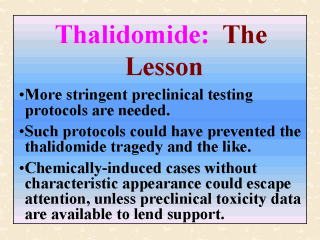| front |1 |2 |3 |4 |5 |6 |7 |8 |9 |10 |11 |12 |13 |14 |15 |16 |17 |18 |19 |20 |21 |review |
 |
From this second
case study, it is clear that birth defects should no longer be thought of as a disease for
which genetic inheritance is the primary causal explanation. As readily illustrated with
thalidomide, malformations can be induced by synthetic drugs or man-made chemicals.
Certain species and their tissue organs appear to be particularly sensitive to the insult
of xenobiotic teratogens. Teratogenicity may also be specific to the time of exposure. For
these reasons, stringent preclinical testing becomes foremost important. Epidemiologists and clinicians may even accept the argument that, had the teratogenicity of a synthetic drug be tested under a more stringent preclinical protocol in the 1950s, the thalidomide tragedy might not have occurred. It is also important for epidemiologists to realize that the thalidomide epidemic involved over 6,000 malformed babies worldwide (Neubert et al., 1999), all having rather unusual characteristic appearance. Yet there may be incidents of common birth defects induced chemically that otherwise would occur spontaneously at high incidence. In that case, the teratogenicity involved may escape the attention of many epidemiologists or clinicians, unless preclinical toxicity data from animal studies are there available to lend some empirical support. In short, data from well-designed preclinical testing can serve to prevent the onset of a chemically-induced episode. And such is apparently the ultimate public health goal of epidemiology. |